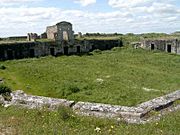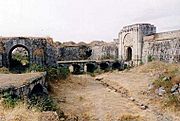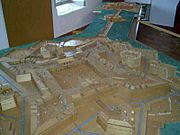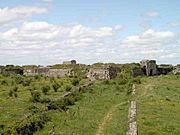Royal Fortress of the Concepcion facts for kids
Quick facts for kids Fortress of the Conception |
|
|---|---|
|
Real Fuerte de la Concepción
|
|
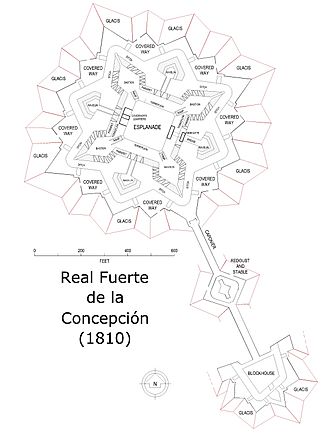
Fortress of the Conception
|
|
| Alternative names | Castillo de Aldea del Obispo Hotel Domus Real Fuerte de la Concepción |
| General information | |
| Type | Star Fortress |
| Architectural style | Vaubanesque style |
| Location | Aldea del Obispo Province of Salamanca |
| Address | Avenida de Portugal, s/n, 37488 Aldea del Obispo, Salamanca, Spain |
| Coordinates | 40°42′11.2″N 6°48′15.6″W / 40.703111°N 6.804333°W |
| Construction started | First fortress, 8 December 1663 (date of the festival of the Immaculate Conception) Second fortress, 1735 |
| Completed | 1758 |
| Renovated | 1735–1758 2006–2012 |
| Demolished | 1808 (partially by the French) 27 July 1810 by the British |
| Design and construction | |
| Architect | Simón Jocquet (1664) Pedro Moreau (1735) |
| Main contractor | Manuel de Lara Churriguera |
The Fortress of the Conception (its full name in Spanish is Real Fuerte de la Concepción) is a special type of fort called a star fortress. It was built in a style named after a famous engineer, Vauban. You can find it about 1 kilometer (0.6 miles) west of the village of Aldea del Obispo in Salamanca province, western Spain. This area is part of Castile and León.
The fortress was built here because it was a very important spot. It's super close to the border between Spain and Portugal, only about 0.6 kilometers (0.4 miles) away. It also sits across from a Portuguese castle called Almeida, which is about 8.8 kilometers (5.5 miles) to the west-north-west. In 2006, the old, unused fortress was sold. It was then turned into a fancy hotel, which opened in 2012.
Contents
Building a Fortress: Its History
In 1640, a war called the Portuguese Restoration War started. The King of Spain, Philip III, wanted Portugal to become part of Spain. This meant Portuguese leaders would lose all their power. So, the Portuguese fought back and became independent again.
On December 1, 1640, a military takeover happened. The Duke of Braganza became the new King of Portugal, John IV. The Spanish King then planned to get Portugal back. Part of his plan was to make the forts along the border stronger. He also wanted to build new ones. The area between the River Côa and the River Águeda became a buffer zone. This was a neutral area between the two kingdoms. The Fortress of the Conception was one of these new forts. It was built by order of the Duke of Osuna, who led the Spanish Army. Its job was to be a military base for the Spanish army to try and take Portugal back.
How the Fortress Was Built
The French military engineer Simon Jocquet was in charge of building the fortress. Work started on December 8, 1663. This day is a special holiday called the Feast of the Immaculate Conception. That's why the new fortress got its name.
The first part of the building was finished very quickly, in just 40 days, by January 20, 1664. This first fort had a large central courtyard. It had five-sided bastions (strong parts that stick out) at each corner. Earthworks (walls made of earth) were built around the outside. They also used bundles of brushwood called fascines and baskets filled with dirt. These were woven around stakes to make small forts called redoubts. About 1,500 foot soldiers and 200 cavalry (soldiers on horseback) were stationed there.
Why the Fort Was Closed in 1664
On July 7, 1664, Spanish and Portuguese armies fought at the Battle of Castelo Rodrigo. The Spanish army did well at first. But then the Portuguese sent 3,000 more soldiers. This extra help turned the battle around. Many Spanish soldiers were captured, and all their cannons were taken. It's said that the Duke of Osuna and John of Austria the Younger escaped by dressing as monks.
After this, the Duke of Osuna lost his high position. King Philip III took over the army. He ordered parts of Fort Conception to be torn down. The fort had been open for less than a year. What was left of it was still sometimes used by Spanish troops in the border area.
Rebuilding the Fortress in 1735
In 1668, Spain officially said that Portugal was an independent kingdom. But both countries still watched the border area carefully. In the years that followed, Portugal made its forts stronger. These included Olivenza, Elvas, Valença do Minho, and Almeida.
To match this, Spain started building a line of stronger forts on its side of the border. After the Bourbon family came to power in Spain with King Philip V, his chief minister, José Patiño, ordered Fort Conception to be rebuilt and made even stronger. The new fort was built on much of the same ground as the old one.
The military engineer Pedro Moreau was in charge of the construction. He worked with the architect Manuel Lara Churriguera. Work started in May 1736. Moreau had to leave sometimes to work on other forts. So, Antonio de Gaver and Juan Giraldo de Chaves took over for him. The fortress was finished in 1758. This was just before another war started in 1762 between Spain and Britain.
During this war, Spain invaded Portugal. They used Concepcion as a military base. But the area around the fortress stayed quiet. When the war ended in 1763, no shots had been fired from or at the fortress.
The Peninsular War
The Peninsular War began when French and Spanish armies took over Portugal in 1807. It got worse in 1808 when France turned against Spain. Because of this, the Fortress of Concepcion fell under French control. On May 24, 1808, French troops led by General Louis Henri Loison marched towards the Fortress of Almeida.
French Control of the Fort
By June 12, Loison focused on the Fortress of Concepcion. The French soldiers told the fort's Governor they were there to help the soldiers inside. But the Governor and his men were worried about the French. They quickly left the fort through a secret back gate called a postern gate. Loison now controlled both Concepcion and Almeida.
By June 16, Loison was ordered to march to the city of Porto. He needed to stop the Portuguese people from fighting against the French. Loison set out, but Portuguese insurgents (rebels) stopped his troops at the town of Mesão Frio, about 93 kilometers (58 miles) northwest of Almeida.
When he went back to Almeida, Loison got new orders from General Junot. He was told to march to Lisbon, where people were also planning to rebel. Before leaving Almeida, Loison moved the cannons and soldiers from Fort Concepcion to Almeida. He also had the northernmost bastions of the fortress blown up. He hoped this would make the fortress useless if the enemy took it.
French Troops Leave
On August 30, 1808, the Convention of Sintra was signed. This agreement said that the French Army, all its gear, and all its luggage had to leave Portugal and eastern Spain. The British Navy would take them from Porto as soon as possible.
By October, British forces had taken back the fortresses of Concepcion and Almeida. Even though General Sir John Moore retreated to A Coruña in January 1809, the fortress stayed in the hands of the Portuguese and British.
1810: Rebuilding and Destruction Plans
Napoleon couldn't lead the army himself. So, in April 1810, he put his most trusted Marshal, Masséna, in charge of the Army of Portugal. This army had 65,000 men, with 20,000 more promised. By May 1810, Wellington's forces were getting stronger with more supplies and soldiers.
Wellington's spies told him about Masséna's new role. A French officer who had left the army also said that the French had moved 80,000 troops to the area. They were getting ready to invade Portugal again. Wellington's plan to stop an invasion from Ciudad Rodrigo was to make his defenses stronger along the border. He ordered the Fortress of the Concepcion to be made strong again. He also wanted the damaged bastions, which the French had blown up in 1808, to be fixed.
Brigadier General William Cox, who was the military governor of Almeida, was in charge of this work. He tried to hire Spanish workers but couldn't. So, he had to use soldiers from the Portuguese 9th Line to do the job. Captain John Burgoyne of the Royal Engineers watched over the rebuilding. Besides the Portuguese soldiers, Burgoyne also had a few skilled Portuguese stonemasons and carpenters.
The workers cleared all the broken pieces from the ditches around the fort. They also put up wooden fences. Repairs were made to the bastions at the north end of the fortress. The bridge into the fortress was fixed, along with the drawbridge, covered paths, and gates.
Burgoyne was also told to place mines in the two strong bastions that hadn't been damaged before. Six tons of gunpowder were put in barrels in each of the four demilunes (outer defenses). More barrels of powder were stacked in the casemates (bomb-proof rooms) of the walls next to the four bastions. Even more explosives were placed in the main arch of the fort's redoubt. The casemates and blockhouse to the southeast of the fortress were packed with three tons of powder.
The idea behind these explosives was simple: if the French were about to capture the fortress, the soldiers leaving would set off the charges. This would destroy the fortress and stop the French from using Concepcion as a base to attack Almeida.
Once the repairs were done, Brigadier Cox kept the Portuguese 9th Line and 120 artillerymen from Almeida to guard the fortress. He also got two howitzers, four six-pounder guns, and four eight-pounder guns. With the weapons, he received 12,000 food portions, 10,000 rounds of ammunition for infantry, and 100 rounds for each artillery gun. Cox also placed four companies of the 45th Foot in the nearby villages of Aldea del Obispo and Vale da Mula. These troops would quickly help the fortress if it was attacked.
The Siege of Ciudad Rodrigo (1810)
On April 26, 1810, the French Army of Portugal began to besiege (surround and attack) the Spanish town of Ciudad Rodrigo. This was the first step before invading Portugal. Masséna's plan was to capture this border town and use it as a base.
On June 25, Wellington was worried. He visited the fortified town of Almeida. He talked with Brigadier-General Cox, the governor of the fortress. He also checked the local guard posts and positions along the border. These were guarded by Crauford's Light Division. Wellington also visited the Fortress of the Concepcion. He looked at the repairs and preparations Captain Burgoyne had made.
After his visit, Wellington went back to Almeida. He wrote a note to Crauford with ideas for changes and improvements. He also suggested how to make a planned retreat when the French attacked, which Wellington expected.
The Siege of Ciudad Rodrigo ended on July 9. The French VI Corps, led by Marshal Michel Ney, took the city. Its Governor, Don Andrés Perez de Herrasti, surrendered his 5,500 Spanish soldiers. They had fought bravely but were defeated when Ney's cannons made a large hole in the walls. The siege had delayed Masséna's invasion plans for Portugal by over a month. But now the French were ready to move west towards Almeida, with Fort Concepcion in their way.
Capturing and Destroying the Fort
Even before Ciudad Rodrigo fell, the French had tested the British guards west of the city, towards the border. On July 4, General Junot and General Sainte-Croix had checked out the area. After some small fights, Junot had looked at the Fortress of Concepcion. Then he pulled his forces back to Ciudad Rodrigo for a short time.
Wellington's plan now was for Burgoyne to get ready to leave the fortress and blow it up with his explosives. By July 4, the Portuguese 9th line, Portuguese Artillery, and the four companies of the 45th foot had moved back to Picton's Division near the town of Pinhel.
At the fortress, three companies of Portuguese Caçadores (light infantry) who had been on guard duty were replaced. Horsemen from the 14th Light Dragoons and two companies of the 95th Rifles took their place. Their job was to guard the fortress and set off the mines as they left.
In the early morning of July 21, Loison's 25th Dragoons, 3rd Hussars, and supporting infantry crossed the Dos Casas stream. They quickly went up the hillside from Aldea del Obispo towards the Fortress of Concepcion. In front of them, retreating fast, were the 14th Light Dragoons.
Captain Brotherton sent one of his officers ahead. He told Burgoyne that his Light Dragoons were retreating and that there wasn't much time before the French would reach the fortress. Brotherton managed to hold off the French long enough for Burgoyne's mines to be set off.
At 4:45 am, a huge explosion threw pieces of the fortress across the countryside. Some men and horses of the dragoons were caught and killed in the blast. Burgoyne reported that one side of the fortress had blown up. But he couldn't tell how much damage was done because the British had to leave so quickly. The fortress was badly damaged. But the French, who now took control, found that only one of the four main mines had exploded. There had been several other smaller blasts, and the fortress's defenses were seriously weakened.
The French Take Over Again
After the explosions, Loison, following Ney's orders, took control of Concepcion and the area around it for the second time. The French would now use Concepcion's closeness to the Fortress of Almeida. They would use it as a base to organize the siege of Almeida.
A lot of activity began as Concepcion was prepared to be the Headquarters for Marshal Masséna. Masséna's staff moved into some of the remaining bomb-proof casemates with their horses. Masséna's main assistant, Pelet, also stayed in a casemate. With all these staff and men, new resources came to the fortress. This included four baking ovens and many bakers. Three companies of Taupin's infantry guarded the fort.
The French army began to besiege Almeida on July 25, 1810. On August 16, Masséna moved into the old Governor's quarters. He wanted to watch the operations himself. However, Masséna's stay at Concepcion was short. By August 26, the Siege of Almeida was over. Masséna's Army of Portugal quickly took over Almeida. Then they moved towards Lisbon.
Wellington's plan was to slow Masséna down along the border near Concepcion. His planned retreat from the border forts gave him time to make the Lines of Torres Vedras stronger. Masséna decided these defenses were too strong to attack. This led to the French eventually leaving Portugal in 1811.
The French Leave Again
By October, Masséna's army was at the Lines of Torres Vedras. These lines were the obstacle that stopped the French from taking Lisbon. Wellington's Allied Army grew stronger. More troops, supplies, and equipment arrived daily from Britain. The Portuguese army was now well-trained, and its numbers had grown.
Napoleon, even though Masséna asked, only sent 7,000 more troops to help the Army of Portugal. But the biggest problem for Masséna was the lack of supplies, both food and ammunition. Masséna couldn't get supplies from Spain. So, his army had to find food by searching the countryside. Wellington, however, had made sure most resources in the area were destroyed or hidden.
By March 1811, the Army of Portugal was starving. Its ammunition and gunpowder were almost gone. On March 5, 1811, Masséna sadly ordered a retreat from Portugal. Just 12.8 kilometers (8.0 miles) south of Concepcion is the border village of Fuentes de Oñoro. The defeat of Masséna's forces at the Battle of Fuentes de Oñoro between May 3 and 4, 1811, was the final event that pushed the French out of Portugal.
Before the battle, Wellington's Allied army had taken positions along the low hills. These hills ran from Fort Concepcion towards Fuentes de Oñoro. The small French group left at the Fortress of the Concepcion saw this buildup. They had no orders to stay and fight. So, they quickly left, without causing any more damage to the fortress.
Gallery
See also
 In Spanish: Real Fuerte de la Concepción para niños
In Spanish: Real Fuerte de la Concepción para niños


